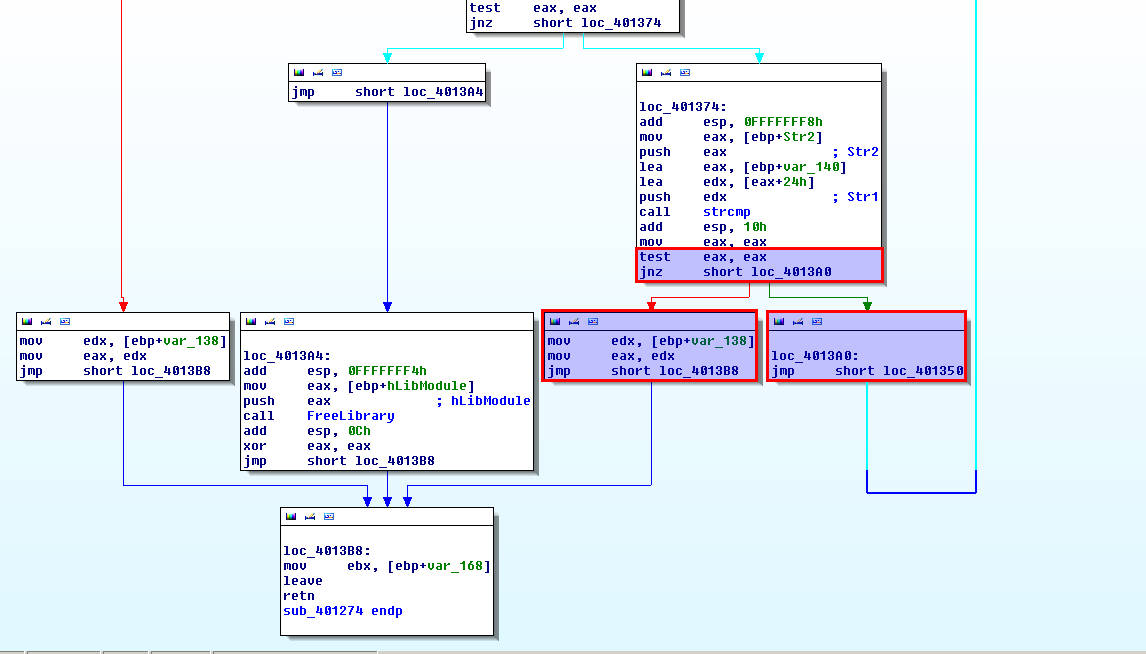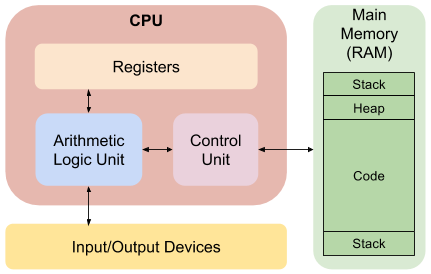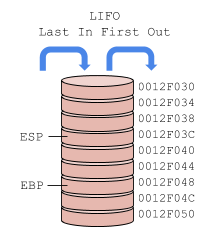Category:Architecture/x86-assembly
| You are here | x86 Assembly
|
Description
Compiler, linker, loader

Thank you for your comprehension.
Flow of execution
The execution flow or control flow corresponds to the logic of a program.
The following code is an extract of a malware named kinject.exe:
[SNIP]
// Inject a process that's already running
if(strcmp(argv[3], "--runtime")==0 || strcmp(argv[3], "-r")==0)
{
//Get Process Id from exe name
if(argc>3 && strcmp(argv[4],"--resolve") == 0)
{
ProcPid = GetPidByName(argv[1]);
if(ProcPid==0) DispError("GetPidByName failed.", DIE);
printf("Process %s has PID: %d\n", argv[1], ProcPid);
}
else
{
ProcPid = atol(argv[1]);
}
HANDLE hProc;
hProc = OpenProcess(PROCESS_ALL_ACCESS, true,ProcPid);
if(hProc==NULL)
{
printf("OpenProcess failed, triggering DebugPrivilege...");
if(LoadPrivilege()!=1) DispError("DebugPrivilege : load FAILED", DIE);
printf(" OK");
}
hProc = OpenProcess(PROCESS_ALL_ACCESS, true,ProcPid);
if(hProc==NULL) DispError("Still can't open process. (Sure it exists ?)", DIE);
printf("Injecting DLL %s in Pid: %d...", argv[2], ProcPid);
InjectDll(hProc, argv[2]);
printf(" OK\n");
getchar();
return 0;
}
[SNIP]
The if and else statements show that the program will take 2 different paths depending on the result of the if test.
In a disassembler, execution flow can be visualized in a tool like IDA-Pro:
Architecture
The x86 architecture
|
The stack
Registers
Instructions
High level logic (functions, if-else, switch, loop, AND, OR)
WORDs
| WORDs | Size (in bytes) |
Size (in bits) |
Max value | Example (registers) |
|---|---|---|---|---|
| BYTE (DB) | 1 byte | 8 bits | 255 | AL, BL, CL |
| WORD (DW) | 2 bytes | 16 bits | 65,535 | AX, BX, CX |
| DWORD (DD) | 4 bytes | 32 bits | 4,294,967,295 | EAX, EBX, ECX |
| QWORD (DQ) | 8 bytes | 64 bits | 18,446,744,073,709,551,615 |
|
Example:
| Type | Value | Result |
|---|---|---|
| dd | 2DF01h | 0002DF01 |
| dw | 0 | 0000 |
| dw | 0 | 0000 |
| db | 0C0h, 6 dup(0), 46h | C000-0000000046 |
The resulting CLSID is 2DF01-0000-0000-C000-000000000046
| Type | Value | Result |
|---|---|---|
| dd | 0D30C1661h | D30C1661 |
| dw | 0CDAFh | CDAF |
| dw | 11D0h | 11D0 |
| db | 8Ah, 3Eh, 0, 0C0h, 4Fh, 0C9h, 0E2h, 6Eh | 8A3E00C04FC9E26E |
The resulting IID is D30C1661-CDAF-11D0-8A3E-00C04FC9E26E.
Signed vs unsigned numbers
Unsigned
Unsigned numbers can only be positive. All bits are used for the number itself.
Binary Decimal Binary Decimal ------ ------- ------ ------- 0000 0 1000 8 0001 1 1001 9 0010 2 1010 10 0011 3 1011 11 0100 4 1100 12 0101 5 1101 13 0110 6 1110 14 0111 7 1111 15
Signed
Signed numbers can be negative or positive. Signed numbers use the left-most bit as a flag to identify the sign (0 = positive / 1 = negative).
Signed positive Signed negative --------------- --------------- Binary Decimal Binary Decimal ------ ------- ------ ------- 0000 0 1000 -0 0001 1 1001 -1 0010 2 1010 -2 0011 3 1011 -3 0100 4 1100 -4 0101 5 1101 -5 0110 6 1110 -6 0111 7 1111 -7
Memory addressing modes
direct, indirect, immediate, register, memory, implied
The accesses can be:
| direct |
mov eax, 0xEBFE mov eax, dword_1234 mov eax, [0x1234] |
|---|---|
| indirect |
mov eax, [ebx+ecx*2+4] |
There are several addressing modes to access memory:
| immediate |
mov eax, 0xEBFE |
Copies the value 0xEBFE into the EAX register |
|---|---|---|
| register |
mov eax, edx |
Copies the content of EDX into EAX |
| memory |
mov eax, dword_0x1234 mov eax,[0x1234] |
Copies the 4 bytes (32 bits) at the memory location 0x1234 into EAX |
| implied (use of base, scaled index and displacement) |
mov eax,[ebp+ecx*2+4] |
Copies the 4 bytes (32 bits) at the memory location specified by the result of the equation ebp+ecx*2+4 into EAX |
Base, scaled index and displacement example
| C source | Assembly |
|---|---|
#include <stdio.h>
int main()
{
char *weekdays[7] = {
"monday",
"tuesday",
"wednesday",
"thursday",
"friday",
"saturday",
"sunday"
};
int daynum;
printf ("Day number? ");
scanf("%d", &daynum);
if (daynum > 0 && daynum < 8) {
printf("Day #%d of week is %s\n", daynum, weekdays[daynum-1]);
} else {
printf("Invalid value!\n");
}
}
|
.text:0804847C mov [ebp+weekdays], offset aMonday ; "monday"
.text:08048483 mov [ebp+weekdays+4], offset aTuesday ; "tuesday"
.text:0804848A mov [ebp+weekdays+8], offset aWednesday ; "wednesday"
.text:08048491 mov [ebp+weekdays+0Ch], offset aThursday ; "thursday"
.text:08048498 mov [ebp+weekdays+10h], offset aFriday ; "friday"
.text:0804849F mov [ebp+weekdays+14h], offset aSaturday ; "saturday"
.text:080484A6 mov [ebp+weekdays+18h], offset aSunday ; "sunday"
.text:080484AD sub esp, 0Ch
.text:080484B0 push offset format ; "Day number? "
.text:080484B5 call _printf
.text:080484BA add esp, 10h
.text:080484BD sub esp, 8
.text:080484C0 lea eax, [ebp+daynum]
.text:080484C3 push eax
.text:080484C4 push offset aD ; "%d"
.text:080484C9 call ___isoc99_scanf
.text:080484CE add esp, 10h
.text:080484D1 mov eax, [ebp+daynum]
.text:080484D4 test eax, eax
.text:080484D6 jle short invalid
.text:080484D8 mov eax, [ebp+daynum]
.text:080484DB cmp eax, 7
.text:080484DE jg short invalid
.text:080484E0 mov eax, [ebp+daynum]
.text:080484E3 sub eax, 1 ; eax = daynum - 1
.text:080484E6 mov edx, [ebp+eax*4+weekdays]
.text:080484EA mov eax, [ebp+daynum]
.text:080484ED sub esp, 4
.text:080484F0 push edx
.text:080484F1 push eax
.text:080484F2 push offset aDayDOfWeekIsS ; "Day #%d of week is %s\n"
.text:080484F7 call _printf
|
Endianness
The x86 Intel architecture is little endian whereas network data is big endian.
Here is an example for an IPv4 (4 bytes): 0x366410AC
0x36 0x64 0x10 0xAC
---- ---- ---- ----
| | | |__ 0xAC = 172
| | |_______ 0x10 = 16
| |____________ 0x64 = 100
|_________________ 0x36 = 54
---------------------
172.16.100.54
Examples
Decryption routine
- Example of a decryption routine
Comments
Pages in this category
Pages in category "Architecture/x86-assembly"
The following 71 pages are in this category, out of 71 total.
S
X
- X86-assembly/High-level-logic/loop
- X86-assembly/Instructions
- X86-assembly/Instructions/add
- X86-assembly/Instructions/and
- X86-assembly/Instructions/bt
- X86-assembly/Instructions/call
- X86-assembly/Instructions/cdq
- X86-assembly/Instructions/cld
- X86-assembly/Instructions/cmp
- X86-assembly/Instructions/cmpsb
- X86-assembly/Instructions/cpuid
- X86-assembly/Instructions/dec
- X86-assembly/Instructions/div
- X86-assembly/Instructions/idiv
- X86-assembly/Instructions/imul
- X86-assembly/Instructions/in
- X86-assembly/Instructions/inc
- X86-assembly/Instructions/ja
- X86-assembly/Instructions/jae
- X86-assembly/Instructions/jb
- X86-assembly/Instructions/jbe
- X86-assembly/Instructions/jecxz
- X86-assembly/Instructions/jg
- X86-assembly/Instructions/jge
- X86-assembly/Instructions/jl
- X86-assembly/Instructions/jle
- X86-assembly/Instructions/jnb
- X86-assembly/Instructions/jnp
- X86-assembly/Instructions/jnz
- X86-assembly/Instructions/jo
- X86-assembly/Instructions/js
- X86-assembly/Instructions/jz
- X86-assembly/Instructions/lea
- X86-assembly/Instructions/lodsb
- X86-assembly/Instructions/loop
- X86-assembly/Instructions/mov
- X86-assembly/Instructions/movsb
- X86-assembly/Instructions/mul
- X86-assembly/Instructions/neg
- X86-assembly/Instructions/nop
- X86-assembly/Instructions/not
- X86-assembly/Instructions/or
- X86-assembly/Instructions/pop
- X86-assembly/Instructions/push
- X86-assembly/Instructions/pushf
- X86-assembly/Instructions/rdtsc
- X86-assembly/Instructions/rep
- X86-assembly/Instructions/ret
- X86-assembly/Instructions/rol
- X86-assembly/Instructions/ror
- X86-assembly/Instructions/sbb
- X86-assembly/Instructions/setle
- X86-assembly/Instructions/setz
- X86-assembly/Instructions/sgdt
- X86-assembly/Instructions/shl
- X86-assembly/Instructions/shr
- X86-assembly/Instructions/sidt
- X86-assembly/Instructions/sldt
- X86-assembly/Instructions/smsw
- X86-assembly/Instructions/stos
- X86-assembly/Instructions/str
- X86-assembly/Instructions/sub
- X86-assembly/Instructions/test
- X86-assembly/Instructions/xchg
- X86-assembly/Instructions/xor
- X86-assembly/Registers



